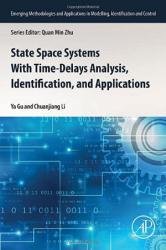 Название: State Space Systems With Time-Delays Analysis, Identification, and Applications
Название: State Space Systems With Time-Delays Analysis, Identification, and ApplicationsАвтор: Ya Gu, Chuanjiang Li
Издательство: Academic Press/Elsevier
Год: 2023
Страниц: 309
Язык: английский
Формат: pdf
Размер: 11.8 MB
State Space Systems with Time-Delays Analysis, Identification and Applications covers the modeling, identification and control of industrial applications, including system identification, parameter estimation, dynamic simulation, nonlinear control, and other emerging techniques. The book introduces basic time-delay systems, architectures and control methods. Emphasis is placed on the mathematical analysis of these systems, identifying them, and applying them to practical engineering problems such as three independent water tank systems and distillation systems. This book contains a wide range of time-delay system identification methods that can help readers master the system controllers’ design methods.
Presents the basic concepts of time delay systems stability analysis and classical time delay system identification methods
Discusses the stability analysis of complex time delay systems
Presents the identification of uncertain and unknown time delay systems
Provides examples of industrial application
In Chapter 1, for the state space model with a unit time delay, by extending the state equation, using the properties of the shift operators, and eliminating some state variables, the state space system with time delay is converted into the form of the input–output expression, which is the identification model of the system. When the states are unmeasurable, they are replaced with their estimates, by using the parameter estimation and known input–output data to estimate states. This chapter proposes the auxiliary model–based least squares identification method, the stochastic gradient identification algorithm, and the least squares–based iterative parameter estimation algorithm for the state space model with a unit time delay. The simulation examples verify the effectiveness of the proposed algorithms.
In Chapter 2, for the state space model with d-step time delay, by using the least squares identification algorithm to estimate the parameters and states, first, the identification model is derived, the unknown noise and state variables in the information vectors are replaced with their estimates, and the parameters are estimated. Then, the parameter estimates are used to compute the states. For the multivariable state space model with d-step time delay, the number of variables is large, and the structure of the model is complex; while some single variable system identification methods can be applied to some of the multivariable systems, these identification algorithms for multivariable systems are not enough. To guarantee the identification accuracy of the algorithm, we also need to do some improvements to the original algorithm. This chapter mainly uses hierarchical identification theory to improve the computational efficiency of identification algorithm. Finally, simulation examples show the effectiveness of the proposed algorithms.
In Chapter 3, for the state space model with multistate delays, the number of delays is large, and the theoretical derivation of multistate delays is more complex than that of a unit time delay. This chapter uses hierarchical gradient–based iterative identification algorithm and hierarchical least squares-based iterative identification algorithm to estimate the parameters of the system.
Chapter 4 considers the identification problem of the state space model with d-step delay for multivariable systems and presents a state estimation-based recursive least squares parameter identification algorithm by using the hierarchical identification principle.
Chapter 5 researches parameter estimation problems for a Hammerstein input nonlinear system with state time delay. Combining the linear transformation and the property of the shift operator, the Hammerstein state space system is equivalent to a bilinear parameter identification model.
In Chapter 6, for the uncertain state space model with time delay, we mainly adopt two kinds of methods, one is the moving horizon estimation algorithm, and the basic idea is to derive the cost function and optimize the objective function; compared with the general Kalman filter algorithm, the proposed algorithm can simultaneously estimate the continuous state and discrete time delay.
Скачать State Space Systems With Time-Delays Analysis, Identification, and Applications